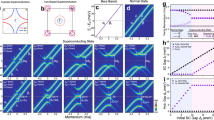Abstract
RECENTLY, considerable interest has been aroused in the observation of 13C-proton coupling constants ( ) in Proton magnetic resonance spectra. It was shown by Müller and Pritchard1 and by Shoolery2 that this coupling constant changes abruptly with changes in the state of hybridization of the carbon atom from the pure sp3 to the sp state. This change is explained as a result of the increasing importance of the Fermi contact interaction between s electrons and nuclear spins1,2.
This is a preview of subscription content, access via your institution
Access options
Subscribe to this journal
Receive 51 print issues and online access
$199.00 per year
only $3.90 per issue
Buy this article
- Purchase on Springer Link
- Instant access to full article PDF
Prices may be subject to local taxes which are calculated during checkout
Similar content being viewed by others
References
Müller, Norbert, and Pritchard, Donald E., J. Chem. Phys., 31, 768 (1959).
Shoolery, J. N., J. Chem. Phys., 31, 1427 (1959).
Müller, Norbert, and Pritchard, Donald E., J. Chem. Phys., 31, 1471 (1959).
Bent, H. A., J. Inorg. Nucl. Chem., 19, 43 (1961).
Burke, John J., and Lauterbur, Paul C., J. Amer. Chem. Soc., 83, 326 (1961).
Author information
Authors and Affiliations
Rights and permissions
About this article
Cite this article
VAN DER KELEN, G. Second-Order Hybridization Effects in the Proton Magnetic Resonance Spectra of the Methyl Tin Chlorides. Nature 193, 1069–1070 (1962). https://doi.org/10.1038/1931069a0
Issue Date:
DOI: https://doi.org/10.1038/1931069a0
This article is cited by
-
Electronic influences in the molecules of group IV organometallic compounds
Theoretical and Experimental Chemistry (1967)
Comments
By submitting a comment you agree to abide by our Terms and Community Guidelines. If you find something abusive or that does not comply with our terms or guidelines please flag it as inappropriate.



